|
|
Recent Progress on Applications of Nano Metal Oxides in Perovskite Solar Cells
WANG Wei-Qi, ZHENG Hui-Feng, LU Guan-Hong, LIU Yang-Qiao, SUN Jing, GAO Lian
2016 Vol. 31 (9): 897–907
 Abstract
Abstract(
1686 )
 HTML
HTML(
10)
 PDF
PDF(552KB)(
1348
)
In recent years, the power conversion efficiency of perovskite solar cells (PSCs) has increased dramatically from 3.8% to 20.1%, approaching to that of recent silicon-based solar cells. Inorganic metal oxides, including TiO2, ZnO, Al2O3, etc., have been widely used as charge transport layers and perovskite supporting scaffords in PSCs. Regarding the cell structures of PSCs, this review discusses the syntheses methods of inorganic compact layers and mesoporous layers made from these inorganic metal oxides, and the modifications (including surface modifications, doping and composites) of these inorganic functional layers, which aim at improving the charge transport properties of these layers and changing the interfacial characteristics with perovskites to enhance the PSCs’ cell performances. Besides, the important issues of such functional layers made from inorganic metal oxides are also discussed.
|
|
|
Properties of Silver Nanostructures Incorporated Perovskite Based Thin Films for Solar Cell Applications
TAN Man-Lin, MA Dong-Cao, FU Dong-Ju, MA Qing, LI Dong-Shuang, WANG Xiao-Wei, ZHANG Wei-Li, CHEN Jian-Jun, ZHANG Hua-Yu
2016 Vol. 31 (9): 908–914
 Abstract
Abstract(
974 )
 HTML
HTML(
9)
 PDF
PDF(480KB)(
1069
)
Silver nanostructures (Ag nanoparticles, Ag@SiO2 core-shell nanoparticles & Ag nanowires) were firstly added into aluminum oxide isopropanol solution to form cellular Al2O3 mesoporous layers for perovskite solar cell applications, respectively. Then CH3NH3PbI3 organic-inorganic hybrid perovskites were fabricated and attached to this matrix. Absorption spectra of Al2O3/CH3NH3PbI3 composite and CH3NH3PbI3 were found to be basically the same in the visible region, indicating that Al2O3 had less impact on the absorption performance of CH3NH3PbI3. However, the incorporation of silver nanostructures could significantly improve the absorption properties of the perovskites, and the best performance could be achieved with the concentration ratios of Ag nanoparticles, Ag@SiO2 core-shell nanoparticles and Ag nanowires of 0.15, 0.3 and 0.15, respectively. Further increasing the concentration of silver incorporation would probably cause halogenation and reduce the absorption properties of CH3NH3PbI3. In addition, the efficiency of perovskite solar cell could be improved from original 6.28% to 7.09% after addition of Ag@SiO2 core-shell nanoparticles. In contrast, the incorporation of Ag nanoparticles & nanowires tended to reduce the short circuit current density and conversion efficiency of the fabricated solar cells, because they could prolong the internal carrier transport path and hence increase the recombination probability of the electron-hole pairs.
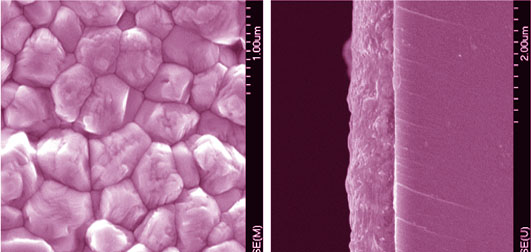
|
|
|
PbS Quantum Dots: Size, Ligand Dependent Energy Level Structures and Their Effects on the Performance of Heterojunction Solar Cells
WANG Heng, ZHAI Guang-Mei, ZHANG Ji-Tao, YANG Yong-Zhen, LIU Xu-Guang, LI Xue-Min, XU Bing-She
2016 Vol. 31 (9): 915–922
 Abstract
Abstract(
1597 )
 HTML
HTML(
31)
 PDF
PDF(700KB)(
1733
)
The conduction band minimum and valence band maximum of colloidal PbS quantum dots with different sizes (2.6-4.5 nm) and different surface ligands (oleic acid or tetrabutylammonium iodide, TBAI) were determined by cyclic voltammetry and absorption measurements. Furthermore, the effect of quantum dot sizes on the performance of PbS quantum dots/TiO2 heterojunction solar cells prepared in air was also studied. The results show that energy level structures of PbS quantum dots strongly depend on the size and ligand on the surface. As the quantum dot size increases from 2.6 nm to 4.5 nm, the conduction band minimum of pristine PbS quantum dots with oleic acid ligands decreases from -3.67 eV to -4.0 eV, while their valence band maximum increases from -5.19 eV to -4.97 eV. However, for PbS quantum dots passivated by TBAI ligands, their conduction band minimum and valence band maximum change from -4.15eV and -5.61 eV to -4.51eV and -5.46 eV, respectively. Devices made of the PbS quantum dots with size of 3.9 nm show the highest power conversion efficiency of 2.32%, which can be ascribed to their proper bandgap, crystal quality and favorable energy-level alignment at the PbS quantum dot /TiO2 interface.
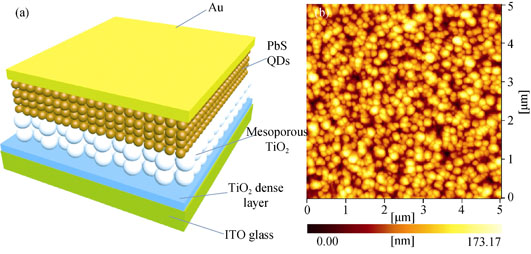
|
|
|
Controlled Synthesis and Catalytic Property of Mesoporous Bimetal Ni-Co/SiO2 Hollow Spheres
SUN Xin-Zhi, DU Fang-Lin
2016 Vol. 31 (9): 923–928
 Abstract
Abstract(
760 )
 HTML
HTML(
9)
 PDF
PDF(426KB)(
942
)
Using silica as template, mesoporous bimetal Ni-Co silicate hydroxide hollow spheres were synthesized by sacrificial template/interface reaction. There morphologies and structures were characterized by scanning electron microscopy (SEM), transmission electron microscope (TEM), X-ray diffraction (XRD), and temperature procedure reduction (TPR). Their reduction rule was explored and catalytic properties of the reduction products on nitrobenzene hydrogenation were investigated. The results show that the structures of bimetal nickel cobalt silicate are core-shell and hollow spheres under 140℃ for 6 h and 12 h, respectively. Bimetal Ni-Co/SiO2 hollow spheres are obtained after reduction of N silicate hydroxide hollow spheres within 5 h at 800℃ with less specific surface area and bigger pore size than before reduction. But the hollow spheres before and after reduction still share the same morphology. Using bimetal Ni-Co/SiO2 hollow spheres as catalyst for conversion of nitrobenzene, the conversion rate attains 67% within 1 h, about 28% higher than that of using commercial Raney Ni.
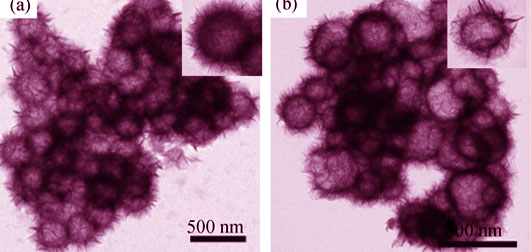
|
|
|
Preparation and Photocatalytic Performance of g-C3N4/Kaolinite Composite
YAO Guang-Yuan, HUANG Wei-Xin, LI Chun-Quan, SUN Zhi-Ming, ZHENG Shui-Lin
2016 Vol. 31 (9): 929–934
 Abstract
Abstract(
959 )
 HTML
HTML(
7)
 PDF
PDF(532KB)(
1099
)
g-C3N4/kaolinite composite photocatalysts were prepared via impregnation method. The microstructure, optical and interface properties of the obtained composites were characterized by X-ray diffraction (XRD), scanning electron microscope (SEM) and UV-visible diffused reflectance spectroscope (UV-Vis DRS), respectively. The as-synthesized KA/g-C3N4(H+)-6︰3 sample exhibits significantly enhanced photocatalytic activity under visible-light irradiation towards degradation of rhodamine B, which is 8.62 times that of the pure g-C3N4. The g-C3N4 and kaolinite are firmly combined together via electrostatic force. The enhanced photocatalytic activity of the g-C3N4/ kaolinite composite is attributed to the improved adsorption capacity and the synergistic effect of the g-C3N4 and kaolinite, which restrains the recombination of electron-hole pairs.
|
|
|
Photoelectrochemical and Photocatalytic Properties of NiFe2O4/TiO2 Nanorod Arrays
GAO Xin, LIU Xiang-Xuan, ZHU Zuo-Ming, XIE Zheng, SHE Zhao-Bin
2016 Vol. 31 (9): 935–942
 Abstract
Abstract(
981 )
 HTML
HTML(
11)
 PDF
PDF(874KB)(
1001
)
Highly ordered one-dimensional TiO2 nanorod arrays (TiO2 NRAs) film was prepared by hydrothermal method. Then through dipping deposition and calcination, the NiFe2O4 modified TiO2 NRAs (NiFe2O4/TiO2 NRAs) was obtained. To analyze the phase and morphology structure of the NiFe2O4/TiO2 NRAs, SEM, TEM, XRD, Raman spectra, XPS, and UV-Vis spectrophotoeter were used. The results showed that NiFe2O4 nanoparticles were uniformly deposited on the surface of rutile TiO2 NRAs, which led to a red shift in absorption spectrum. Considering the photoelectric conversion performance, it is discovered that photocurrent of NiFe2O4/TiO2 was greatly improved compared with that of bare TiO2 under visible light irradiation. The photocurrent density of NiFe2O4/TiO2 NRAs was 12 times that of bare TiO2 NRAs in the voltage-current curve, and 8 times that of bare TiO2 NRAs in the current changes with time switch light. Under visible light irradiation, degradation rate of UDMH by NiFe2O4/TiO2 NRAs was about 3 times as much as that of bare TiO2 NRAs. Furthermore, schematic of photocatalytic activity under visible light was explored.
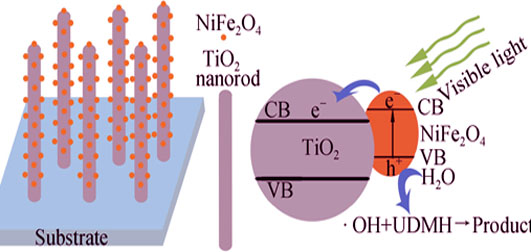
|
|
|
Effect of Sintering Temperature on Structure and Electric Performance of La0.67Ca0.33-xSrxMnO3 Ceramic
SUN Shu-Miao, YU Yang, MI Le, YU Yun, CAO Yun-Zhen, SONG Li-Xin
2016 Vol. 31 (9): 943–947
 Abstract
Abstract(
632 )
 HTML
HTML(
1)
 PDF
PDF(497KB)(
949
)
Double-doped La0.67Ca0.33-xSrxMnO3(x=0, 0.05, 0.15) powders were synthesized by traditional solid-state reaction method. Effects of sintering temperature on structure, micro morphology and metal-insulator phase transition temperature of La0.67Ca0.33-xSrxMnO3 ceramic were systemically studied. The results showed that sintering temperature had little influence on crystallinity or micro morphology of as-prepared ceramic, while double-doping effectively changed the phase transition temperature of the ceramics. When the ceramics sintered at 1400℃, the metal-insulator phase transition temperature increased from -20℃ to 6℃ and the ceramics stabilized in orthorhombic structure as the doping level varing from x=0 to x=0.05. At the doping level x=0.15, the crystal structure changed from rhombohedral to orthorhombic and the metal-insulator transition temperature was 17℃. Under the same doping concentration, the metal-insulator phase transition temperature of the ceramics increased with the increase of sintering temperature. The above mentioned material may be an ideal candidate for active thermal control technology of long life satellites.
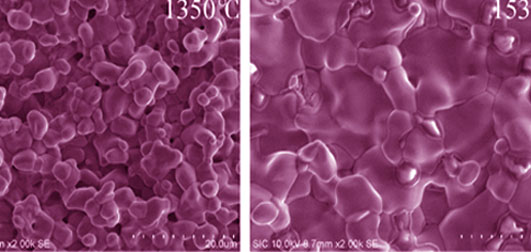
|
|
|
Preparation and Luminescence Properties of Lu2SiO5: Ce3+ Thin Film
WU Shuang, LIU Bo, CHEN Shi-Wei, ZHANG Juan-Nan, LIU Xiao-Lin, GU Mu, HUANG Shi-Ming, NI Chen, XUE Chao-Fan
2016 Vol. 31 (9): 948–954
 Abstract
Abstract(
592 )
 HTML
HTML(
4)
 PDF
PDF(551KB)(
812
)
Lu2SiO5: Ce3+ thin film is a promising material for X-ray detection due to its high light output, short decay time, high density, and high spatial resolution. In present work, Lu2SiO5: Ce3+ thin films were prepared by Sol-Gel method. The optimal experimental conditions were obtained concerning solid content, adhesive content, water content, and annealing progress. Under the conditions with air humidity of 85%, sol’s H2O-Si ratio of 6.6, appropriate amount of PEG400, optimized solid content, and sintering starting from 450℃, the thin films are prepared crack-free with high transparence and excellent luminescent properties. The thickness of its single layer is 167 nm. It is found that water content is the major factor that causes film foggy, and sintering progress affects the reaction of organics and crystallization. Furthermore, solid content and the adhesive content are the two factors controlling the film thickness. The present study may promote the application of Lu2SiO5: Ce3+ thin films in detection systems.
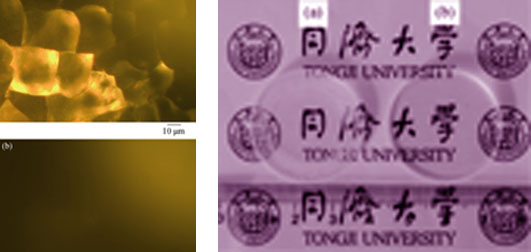
|
|
|
Effects of In, Ta Co-doped on the Sinterability and Stability of BaCeO3
YANG Chun-Li, YAN Min, LI Wei
2016 Vol. 31 (9): 955–960
 Abstract
Abstract(
614 )
 HTML
HTML(
2)
 PDF
PDF(545KB)(
790
)
BaCe0.7In0.3-xTaxO3-δ powders were synthesized by a modified citrate method. The powders were pressed into pellets, and then sintered at 1150℃, 1250℃ and 1350℃. The phase composition and the microstructure were investigated by using X-ray diffraction patterns and scanning electron microscope, respectively. The conductivity was measured by AC impedance method. The results indicate that porosities of the samples sintered at 1350℃ are less than 10% and the sample’s sinterability becomes better with the increasing doping amount of In. The doping of In can improve stability of the BaCeO3 based powders against water, but not improve its stability against high concentration CO2. However, Co-doping with In and Ta definitely improves the samples’ resistance against CO2 and the higher Ta-doping level, the much more stability is, while the conductivities in wet H2 decrease. Conductivity of the BaCe0.7ln0.25Ta0.05O3-δ sample at 800℃ in wet 10% H2 atmosphere reaches 1.16×10-3 S/cm.
|
|
|
Tailoring of Pore Structure of Coal-based Carbon Foam
XU Guo-Zhong, JIN Wen-Wu, ZENG Xie-Rong, ZOU Ji-Zhao, XIONG Xin-Bai, HUANG Lin, ZHAO Zhen-Ning
2016 Vol. 31 (9): 961–968
 Abstract
Abstract(
682 )
 HTML
HTML(
2)
 PDF
PDF(891KB)(
932
)
Vitrinite-concentration of fat coal was used as precursor to prepare carbon foams by nitrizing under high pressure. Influences of foaming temperature, pressure and time on the pore structure of carbon foams were investigated, whose prarameters include bulk density, porosity, morphology, pore cell average diameter, and the distribution of pore cell diameter and pore throats. The morphology of pore cell was observed by SEM. The distributions of pore cell diameters and pore throats as well as the mean diameter were calculated using analytical software of Nano Measurer 1.2. Results show that the nucleation of microcellular thermoplastic foam can qualitatively reveal the variable trend of pore cell structure of carbon foams. Rising of the foaming temperature results in nucleation volume density enhancement. Meanwhile, the rising temperature reduces the gas solubility in plastic mass, which is not conducive to the cell growth. Increasing foaming pressure leads to pore cell density enhancement, whereas the critical nucleation radius decrease. In addition, the increased foaming pressure exacerbates thermal polymerization reaction, increasing viscosity of the plastic mass, which is not conducive to the growth of pore cell. Extending foaming time enables thermal polymerization more sufficiently, which influences the viscosity of the plastic mass and further affects the pore structure.
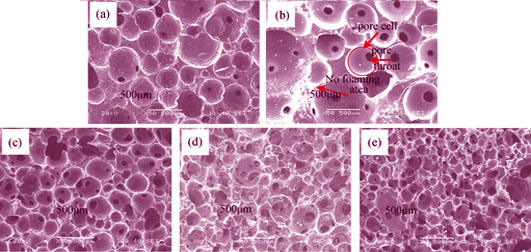
|
|
|
Interface Structure and Stress Analysis of Carbon Fiber Reinforced Laminated Woodceramics
SUN De-Lin, HAO Xiao-Feng, HONG Lu, TANG Zhi-Hong, ZHANG Shao-Ming
2016 Vol. 31 (9): 969–975
 Abstract
Abstract(
646 )
 HTML
HTML(
7)
 PDF
PDF(487KB)(
665
)
To study the interface structure and loading conditions of fiber reinforced woodceramics composite, a laminated woodceramics were prepared by using liquification wood, carbon power and carbon fiber. Scanning electron microscope (SEM) and a high-revolution transmission electron microscope (HRTEM) were employed to observe the basic structure and interface, and a micro-raman spectrometer (MRS) was used to detect the G’ band shifts of stretch sample to judge the situation of interface bond. Meanwhile, the function and way of interface layer in the process of stress transfer were numerical analyzed by using Abaqus based on bilinear softening constitutive mode. The observation of SEM and HRTEM indicates the carbon fiber reinforced woodceramics presents a clear laminated structure, of which has a strong interface bonding between amorphous carbon and glassy carbon. The test of MRS show that the G’ band of pressure sintering specimen shifts to low wavenumber at high extent, which proves that pressure sintering can improve the interface bonding strength between glassy carbon and carbon fiber. The numerical analysis shows that the interface layer plays an important role in the stress transfer between carbon fiber and matrix material in the loading process. As the intension and thickness of interface layer increase, the loading and the equivalent stress transfer to matrix material increases.
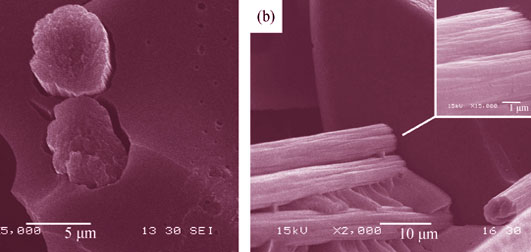
|
|
|
Preparation and Application of Three-dimensional Graphene Nanospheres in Lithium Ion Battery
XU Li, SHENG Peng, CHEN Xin, HAN Yu, LIU Shuang-Yu, WANG Bo, ZHAO Guang-Yao, LIU Hai-Zhen
2016 Vol. 31 (9): 976–980
 Abstract
Abstract(
819 )
 HTML
HTML(
12)
 PDF
PDF(645KB)(
1084
)
Three-dimensional graphene nanospheres were prepared by direct-current arc discharge method. The microstructure and morphology of the graphene nanospheres were characterized by transmission electron microscope (TEM), scanning electron microscope (SEM), Raman spectrum and X-ray diffraction (XRD) pattern. The electrochemical properties of the three-dimensional graphene nanospheres as the anode materials of lithium ion battery were studied by alternating current impedance and constant current charge-discharge cycle performance. The results show that, at current density of 0.05 A/g, the graphene nanospheres as the anode materials have a high first discharge capacity of 485.9 mAh/g, which is better than has the carbon black (401 mAh/g). When the current density increases to 1 A/g, the three-dimensional nanospheres can still achieve a capacity of 185.4 mAh/g. The three-dimensional nanospheres have little capacity decay after 100 cycles at current density of 0.5 A/g and 2.5 A/g. The results show that the three-dimensional graphene nanospheres have a higher capacity than carbon black as the anode for lithium ion battery, and they have excellent cycling stability, too.
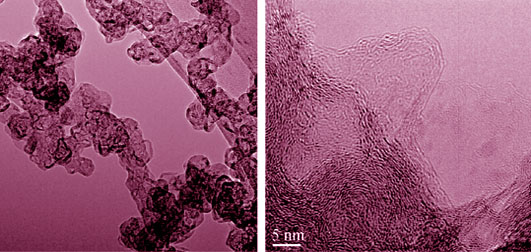
|
|
|
Effect of Al Addition on Electrical Properties of ZnO-based Varistor Ceramics
LIN Jia-Jun, LI Sheng-Tao, HE Jin-Qiang, LIU Wen-Feng
2016 Vol. 31 (9): 981–986
 Abstract
Abstract(
676 )
 HTML
HTML(
9)
 PDF
PDF(509KB)(
769
)
The influences of trace ionic Al addition on the microstructure, electrical properties and intrinsic defects concentration of ZnO-based varistor ceramics were investigated. The results show that the peak value of imaginary permittivity can be used to represent intrinsic defect concentration. Trace ionic Al addition greatly reduces the intrinsic defect concentrations, i.e. the peak value of imaginary permittivity, representing the oxygen vacancy defect decreases from 88.8 to 1.7, and the corresponding zinc interstitial defect decreasing from 133.4 to 8.1. With the increase of ionic Al addition, the varistor voltage increases from 235 V/mm to 292 V/mm and the average grain size decreases from 9.15 μm to 6.24 μm. The results indicate that Al addition effectively restrains the formation of intrinsic defects in ZnO-based varistor ceramics, leading to the change of microstructure and electrical properties. Furthermore, the inhibition mechanism of Al addition to the intrinsic defects in ZnO-based varistor ceramics is discussed, and the relationships between microstructure, electrical properties, dielectric properties and intrinsic defects are established.
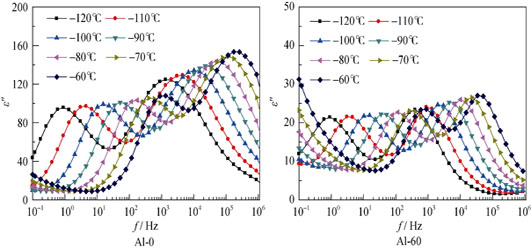
|
|
|
Rare Earth Oxide Refractory Metal Salt Impregnated W Based Directly-Heated Cathode
QI Shi-Kai, WANG Xiao-Xia, LUO Ji-Run, HU Ming-Wei, LI Yun
2016 Vol. 31 (9): 987–991
 Abstract
Abstract(
608 )
 HTML
HTML(
4)
 PDF
PDF(423KB)(
902
)
Cathode plays an important role in the magnetron. In order to enhance the emission current, reduce the operation temperature and prolong the lifetime of the pure W cathode applied in the magnetron, a new La2O3/Y2O3-Gd2O3-ZrO2 impregnated W based directly-heated cathode was developed. The thermionic emission properties of the La2O3/Y2O3-Gd2O3-ZrO2 impregnated cathode were measured. The results show that the La2O3-Gd2O3-ZrO2 impregnated cathode can provide more than 0.18 A /cm2 current density for the space charge limitation (SCL) at 1600℃. Under the same thermionic emission level, the working temperature of the La2O3-Gd2O3-ZrO2 impregnated cathode is at least 300℃ lower than that of the pure W cathode. Lifetime of the La2O3-Gd2O3-ZrO2 impregnated cathode reaches 2100 h at 1750℃ with dc load of 0.5 A/cm2. The Y2O3-Gd2O3-ZrO2 impregnated cathode can provide more than 0.6 and 3.4 A /cm2 current density for SCL at 1400℃, 1700℃, respectively. Under the same thermionic emission level, the working temperature of the Y2O3-Gd2O3-ZrO2 impregnated cathode is at least 400℃, lower than that of the La2O3-Gd2O3-ZrO2 impregnated cathode. Lifetime of the Y2O3-Gd2O3-ZrO2 impregnated cathode reaches 2600 h at 1600℃ with dc load of 1.5 A/cm2. At last, the thermionic emission mechanisms of the two new impregnated cathodes are discussed reasonably.
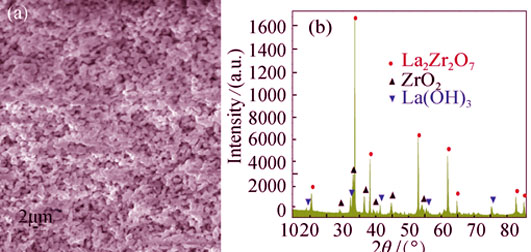
|
|
|
In-situ Synthesis and Discharge Performance of Ni-NiCl2 Composite as Cathode Materials for Thermal Batteries
CHU Ying, LI Yun-Wei, WU Qi-Bing, HU Jing, TIAN Qian-Qiu, HU He-Long, ZHU Yong-Ping
2016 Vol. 31 (9): 992–996
 Abstract
Abstract(
992 )
 HTML
HTML(
19)
 PDF
PDF(645KB)(
1078
)
As a high potential compound, NiCl2 is an ideal anode material for high powder thermal battery, but its small specific surface area and poor conductivity hinder the application in thermal battery. In present study, The Ni-NiCl2 composite with high specific surface area and conductivity was prepared by sublimation and in-situ synthesis, as cathode materials for thermal batteries. The precursor material NiCl2·6H2O was dried to dehydrate and sublimated at 850~900℃ in Ar atmosphere successively. And then the yellow sublimed powder was reduced at 300~500℃ in Ar + H2 atmosphere for 1 h. Finally, the Ni and NiCl2 composite powders were formed. Thermoanalysis, crystal structure, in-situ synthesis process and electrochemical performance of the powders were analyzed. The results show that NiCl2 crystal grows along the direction perpendicular to c axis and formed a layered structure of 200-300 µm in the sublimation process. The resistivity of Ni-NiCl2 composite is reduced with the increase of elemental Ni content. The discharge curve of LiSi︱LiCl-LiBr-LiF︱NiCl2 thermal batteries with Ni-NiCl2 (5wt% elemental Ni) as anode material at 1000 mA/cm2 is more stable and has a shorter activation time, as compared to the discharge curve with pure NiCl2 as anode material.
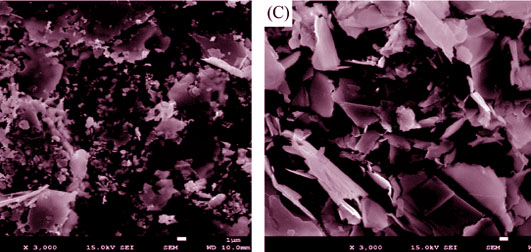
|
|
|
Microstructure and Thermoelectric Properties of p-type Si80Ge20B0.6-SiC Nanocomposite
YANG Xiao-Yan, WU Jie-Hua, REN Du-Di, ZHANG Tian-Song, CHEN Li-Dong
2016 Vol. 31 (9): 997–1003
 Abstract
Abstract(
973 )
 HTML
HTML(
4)
 PDF
PDF(553KB)(
1088
)
P-type silicon germanium (SiGe) alloys, Si80Ge20B0.6, with homogeneously dispersed SiC nanoparticles were prepared by ball milling and subsequent spark plasma sintering. The influence of grain size reduction of SiGe matrix and SiC nanoparticle dispersion on electrical and thermal transport properties were investigated. A significant reduction in lattice thermal conductivity is achieved by a more pronounced grain boundary scattering of phonons introduced by grain size reduction after ball milling. Dispersing SiC nanoparticles in the Si80Ge20B0.6 matrix effectively reduces the conduction of heat by providing additional phonon scattering centers. A dimensionless figure-of-merit (ZT) of 0.62 at 1000 K is obtained in nanostructuring Si80Ge20B0.6 incorporated with only 0.5vol% SiC nanoparticles, which is 17% higher than the parent Si80Ge20B0.6 matrix and about 30% higher than p-type SiGe alloy used in the radioisotope thermoelectric generator in space missions.
|
|
|
Crystal Growth and Characterization of the Rare-earth Orthoferrite Sm0.8Tb0.2FeO3 Single Crystal
ZHAO Xiang-Yang, MAN Pei-Wen, XIE Tao, WU An-Hua, SU Liang-Bi
2016 Vol. 31 (9): 1004–1008
 Abstract
Abstract(
712 )
 HTML
HTML(
1)
 PDF
PDF(330KB)(
920
)
Sm0.8Tb0.2FeO3 single crystal was grown by the floating zone method. Laue back reflection was used to check the crystal’s quality and orientation. The temperature dependence of the magnetization under ZFC process was measured in an external field 500 Oe along c-axis. A clear spin reorientation is observed in the range of 360-400 K. Considering the recent report that the spin reorientation transition temperature of Sm1-xTbxFeO3 is linear decreased with the increase of Tb ions content, the present data reveals the changed Fe3+-Re3+ super-exchange interaction. The curve of temperature dependence of thermal expansion exhibits three phase transitions at about 250 K, 350-480 K, and 700 K, respectively. The abnormal phase transition observed at 250 K may be resulted from the change of rare earth ions moment orientation polarized by Fe3+ sub-lattice net moment. The spin reorientation transition takes place in a temperature range from 350 K to 480 K. The iron spins transform from antiferromagnetic ordered arrangement to paramagnetic disordered arrangement at ~700 K.
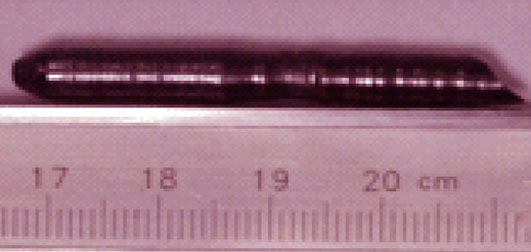
|
|